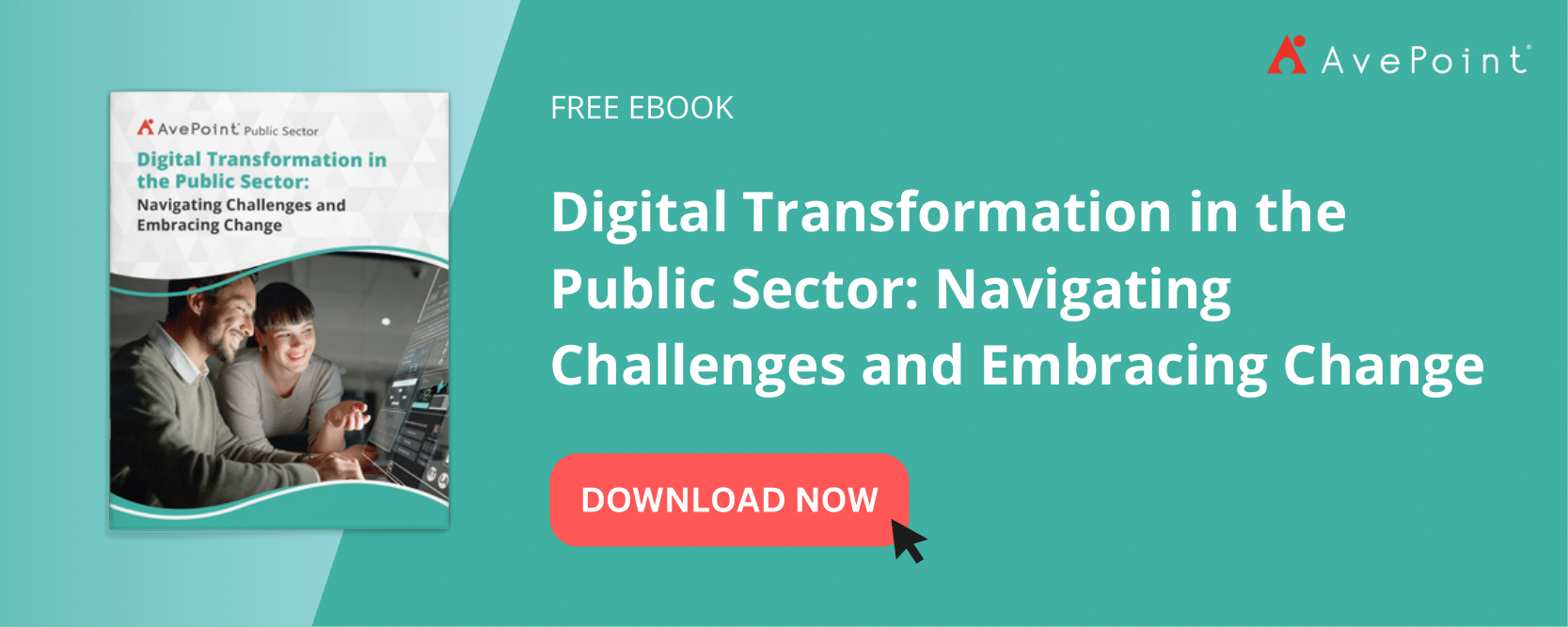Collaboration services like Microsoft 365 have been vital for communication and collaboration in organizations the world over, especially since the pandemic started. But how has this impacted collaboration between federal offices and agencies?
In this week’s episode of #O365 Hours, I sat down with Office Apps & Services MVP Jay Leask to talk about the overall state of collaboration in the public sector, including how collaboration has changed over time and how COVID-19 precautions have impacted things. Watch our discussion below or read the full transcript at your convenience!
Guests: Jay Leask, Director of Federal Strategy and Strategic Accounts at AvePoint (visit his website here)
Topics Covered:
- Maybe a good place to begin is to talk about some of the differences between collaboration platforms available commercially versus to GOV workers. I know Microsoft has different offerings for GOV. What are some of the nuances?
- How has collaboration changed for gov? My experience after leaving Microsoft back in 2009 was that federal and local groups were still very much against cloud.
- So what is the state of collaboration in government today? What are the barriers that you see for how teams are working together? Are there still components missing?
Microsoft has different offerings for GOV. What are some of the nuances?
Well, there’s:
- GCC, which is a FedRAMP moderate environment
- GCC High, which is designed after FedRAMP High (although it is still in progress)
- DOD, which is specifically for the Department of Defense and related agencies
- Finally, there’s the oncoming secret clouds
So, there are a number of different offerings.
In terms of nuances, every time you deploy something—a new major feature—you have to go through an approval process, especially at these highly sensitive workspace tenants. Due to this and issues such as capability gaps, there can be delays.
As far as differences go, the first one is Yammer. Yammer does not exist in any of the government clouds, and that will probably continue. There are some approval processes you can go through, but it will always be in a commercial environment beyond that.
On the administrative side, there’re some differences in the capabilities that you have in order to automate your administration. For example, information governance features are still being rolled out into higher clouds. There are also features like Microsoft Viva (the employee experience platform) that still have an integration in the works. I think Connections in government topics is starting to roll out as well and should help with the surfacing of information.
It’s all about timing. If it’s a major feature, we’re probably six to 18 months from it getting into these higher cloud tiers. If it’s just an update to an existing feature then there’s a much greater chance that it might roll out simultaneously. For instance, a lot of these updates to Microsoft Teams, are coming out right on top of the commercial release. The government has traditionally held a very strong grip around updates to their network; any time you’re updating a server or end user piece of software, you have to communicate what’s coming and have a very strong procedure. So, these things can take time.
How has collaboration changed for GOV?
There’re still security issues that you need to have a plan for, but Microsoft’s government cloud is incredibly secure overall. The amount of money that is put into security by Microsoft vastly outweighs any amount of money any single organization can put into securing their environment.
We’ve all seen malicious insiders get something that you didn’t think to secure because it was inside your network, right? With the tools from Microsoft there’s a larger surface area and attack vector, but there are also more controls to secure your information both externally and internally. So planning is still critical, but there’s more of a healthy worry rather than a dire worry.
But the difference is that even as recently as a few years ago there was a cloud security fear that kept federal agencies from moving to the cloud. That obviously changed when COVID hit. I think now they’re seeing, “Hey, this can be safe. We just need to be smart about it.”
On the flip side of that, some organizations may think that since Microsoft touts that they have all of these certifications and standards, they’re secure by simply using Microsoft 365. That’s another incorrect way of looking at things; independent security planning is still a must.
A major reason for this is because shadow IT is still out there. No matter what sector you’re working in, when you see that behavior, you need to ask questions. And rather than just shutting it down, you need to understand why and how it’s happening. This is why I always say that the definition of success for an IT organization is no longer “I deployed this software” or “I migrated the content from one environment to the next.” Instead, you have to home in on why you deployed it in the first place and put the appropriate controls around it.
What’s the state of collaboration in government today? What are the barriers that you see for how teams are working together? Are there still components missing?
I think with the pandemic now in our rear-view mirror, organizations and the government alike have come to understand that it was collaboration technology that allowed us to be as productive as we were able to be. For one, the government learned that employees can successfully work remotely. When you can prove that your employees can work remotely—while also determining which employees can’t—you can change how you do business in a positive way.
That’s the first thing we learned. The second thing we learned is that proper collaboration tools are mission critical for success even if you’re not allowing people to work remotely. However, assuming that everyone who needs to work together is in the same office is a mistake. The department of defense has millions of government contractors and military employees all across the world who need to communicate and collaborate with people who aren’t in their office. That’s absolutely imperative to the success of their mission.
I think the next thing we learned is that in order for collaboration in gov to work, it has to get more centralized. You can’t rely on a SharePoint farm in someone’s desk to support an enterprise of tens of thousands or hundreds of thousands (or in the Army’s case, over a million users). You have to have an enterprise capable solution that not only handles the scale, but enables cros- team collaboration, breaking down the silos of what we’ve seen for decades, and enabling someone from this division to work with someone from that division and share information safely.
In government, we have agencies that have previously never had a central collaboration space all coming into one location. We have central IT organizations suddenly going, “Wait, we don’t have the budget or scale or employees to handle this.” And we have the end user departments going, “But we need this to be successful!” So, it’s really a major shakeup of where we were even three years ago. But I think a lot of benefit has come from these advancements in digital collaboration.


